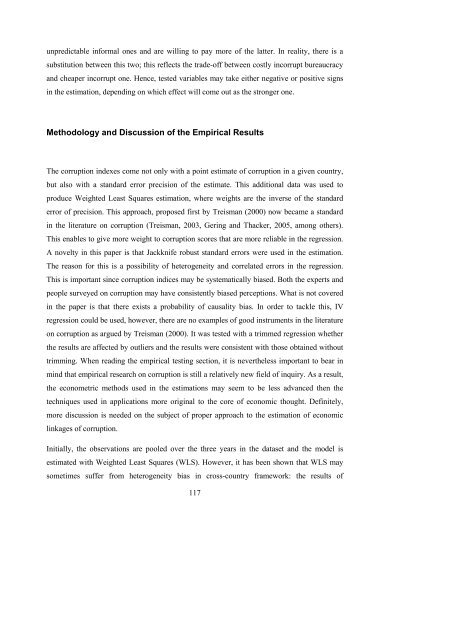PDF, GB, 139 p., 796 Ko - Femise
PDF, GB, 139 p., 796 Ko - Femise
PDF, GB, 139 p., 796 Ko - Femise
You also want an ePaper? Increase the reach of your titles
YUMPU automatically turns print PDFs into web optimized ePapers that Google loves.
unpredictable informal ones and are willing to pay more of the latter. In reality, there is a<br />
substitution between this two; this reflects the trade-off between costly incorrupt bureaucracy<br />
and cheaper incorrupt one. Hence, tested variables may take either negative or positive signs<br />
in the estimation, depending on which effect will come out as the stronger one.<br />
Methodology and Discussion of the Empirical Results<br />
The corruption indexes come not only with a point estimate of corruption in a given country,<br />
but also with a standard error precision of the estimate. This additional data was used to<br />
produce Weighted Least Squares estimation, where weights are the inverse of the standard<br />
error of precision. This approach, proposed first by Treisman (2000) now became a standard<br />
in the literature on corruption (Treisman, 2003, Gering and Thacker, 2005, among others).<br />
This enables to give more weight to corruption scores that are more reliable in the regression.<br />
A novelty in this paper is that Jackknife robust standard errors were used in the estimation.<br />
The reason for this is a possibility of heterogeneity and correlated errors in the regression.<br />
This is important since corruption indices may be systematically biased. Both the experts and<br />
people surveyed on corruption may have consistently biased perceptions. What is not covered<br />
in the paper is that there exists a probability of causality bias. In order to tackle this, IV<br />
regression could be used, however, there are no examples of good instruments in the literature<br />
on corruption as argued by Treisman (2000). It was tested with a trimmed regression whether<br />
the results are affected by outliers and the results were consistent with those obtained without<br />
trimming. When reading the empirical testing section, it is nevertheless important to bear in<br />
mind that empirical research on corruption is still a relatively new field of inquiry. As a result,<br />
the econometric methods used in the estimations may seem to be less advanced then the<br />
techniques used in applications more original to the core of economic thought. Definitely,<br />
more discussion is needed on the subject of proper approach to the estimation of economic<br />
linkages of corruption.<br />
Initially, the observations are pooled over the three years in the dataset and the model is<br />
estimated with Weighted Least Squares (WLS). However, it has been shown that WLS may<br />
sometimes suffer from heterogeneity bias in cross-country framework: the results of<br />
117

















